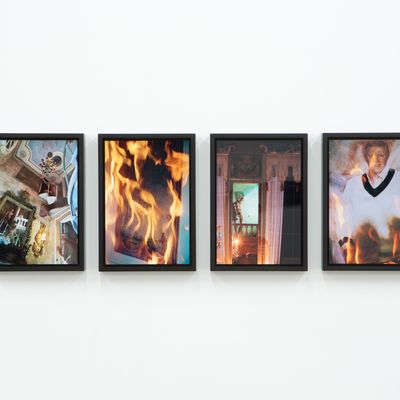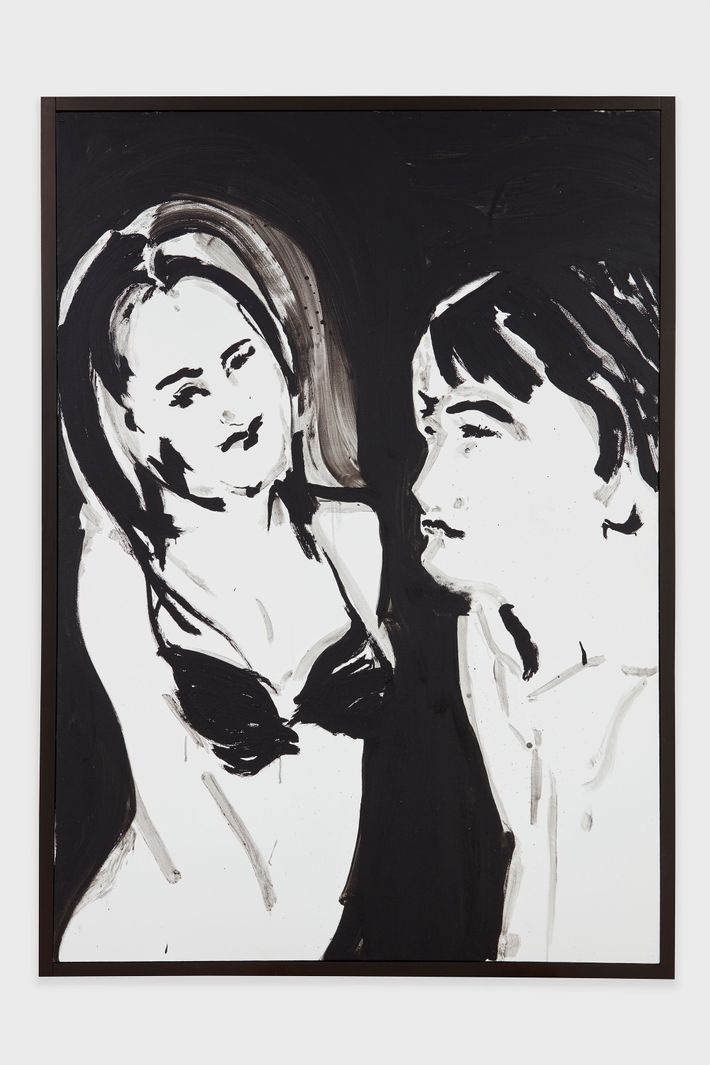
A close-up of a half-closed eye, red and watering, hangs in an oval frame at the entrance to Matthew Leifheit’s exhibition “Fire Island” at Bushwick’s Deli gallery. “It’s like a Victorian ‘lover’s eye,’” the artist attests, “but instead represents a diseased, blurry vision — camera vision. For me that picture is about the symbolic challenge of photography, which is inherently morbid — sick, kind of.”
The rest of the 40 photographs in the exhibition are rectangles, ten inches tall, some narrower portraits, others wider landscapes, all hung in a straight line — a flickering ribbon encircling the room. They’re all night scenes shot last summer around Fire Island’s Cherry Grove, showing bodies and environments in various stages of bloom and decay, in plush interiors or sullen landscapes.
Printed directly onto aluminum, the surface of the photographs feels liquified, almost mirrored. They are objects, and their materiality reminds you of what is missed when you only see images. “I wanted the color itself to be expressive because digital cameras create these very neutral images,” Leifheit told me. He used Kodak Gold — “vacation film from my childhood” — a consumer-grade film whose darks slant toward green.
Wave (Hudson and MeHow) (2018) shows two wrestling bodies flash-lit in the evening surf, the water around them surging an improbable violet-blue. “Right before it gets completely dark, there is that last flash of blue in the summer,” Leifheit explains. “There are only a few moments when the artificial lights that I have will balance with that flash of blue.” In another panoramic nocturne, Hue (After the Fire I) (2018), a nude stands beside a bog, lit by a combination of blue and white lights against a black sky. The difference in temperature between the warm and cool illumination carves the image volumetrically. A similar dynamic is exploited in the photographs of dancers at the Ice Palace, the old wooden club that is the center of nightlife in Cherry Grove, where flashing oranges press against icy blues. The candy-colored imagery recalls James Bidgood’s film Pink Narcissus (1971) and R.W. Fassbinder’s Lola (1981), whose extremes of artifice evoke heat waves of lust.
Taken in low light with long exposures, upon close inspection the images break down subtly into a kind of granular abstraction. Somehow their feeling of lurking in the shadows, not quite making out what is going on, intensifies the erotic charge. The viewer is positioned as someone cruising, catching glimpses. Images taken inside the Belvedere — the fantastical all-male, clothing-optional guest house built in the late 1950s by a successful department store window dresser, in tribute to Venice — roil with seamy camp. For example, two lithe young men lounge in The Marie Antoinette Room (After Velázquez) (2018), the décor drenched in peach and olive florals. One lies on the bed foregrounding his prominent pale ass, looking into an oval mirror propped against the wall — a composition aping Velázquez’s famous The Toilet of Venus (The Rokeby Venus) (1647) in London’s National Gallery. That painting is a machine for generating desire that the viewer is locked into and outside of simultaneously, and this interplay of distanced display is typical of Leifheit’s exhibition as a whole.
Leifheit has an encyclopedic knowledge of homoerotic photography. While in graduate school at Yale, he completed a multi-year study of the archives of photographer George Platt Lynes and his circle, which culminated in an artist’s book, Your Giorgio (2017). Major inspiration also came from Lynes’s friends Paul Cadmus and Jared and Margaret French, who made collaborative work in the mid-20th century as “PaJaMa.” “Part of what drew me to Fire Island was studying those PaJaMa photographs and looking at the way the landscape was a canvas for surrealism,” Leifheit told me. “It’s a miniature forest with full-sized people — already good. The low horizon — very psychological.” And his creating queer images in Fire Island itself takes up on a long tradition which ranges from fine art to kitsch to more workaday erotica (lots of porn has been shot there, after all.) But his work departs from, say, the idealized pre-AIDS Polaroids of Tom Bianchi, or more recently the work of Wolfgang Tillmans, who’s taken up seasonal residence there, since those pictures radiate with summer sun. “There are not really photographs of Fire Island at nigh t —and so much of what happens there happens at night,” Leifheit says, “so I feel like I’m just showing a different side of the place.”
Nicole Wittenberg likes to quote Oscar Wilde: “It is only shallow people who do not judge by appearances. The true mystery of the world is the visible, not the invisible.” She understands style as embodying an attitude toward being — able to weave the visual effect of San Zachariah’s flooded crypt with compositions from Degas’s monotypes and the perfect lines of a Balenciaga skirt. She’s fascinated by them all because of how they look. Approaching her show “Them There Eyes” at the Lower East Side’s (unfortunately soon to close) Yours Mine & Ours gallery, you catch a glimpse of a large black-and-white painting — Angela (2018) — completely filling the plate glass storefront. Entering the space, three more towering figures come into view. She forces a confrontation by installing these four large works — each seven feet tall by five feet wide — into a very small room. All are made with wax and dark pigment on canvas. Wittenberg says they’re an attempt to expand the marks and speed of her ink studies to environmental scale. “I had never really seen drawings get that large in those terms,” she explains. “I’ve seen drawings that are about mark-making processes that expand — small marks that accumulate to create a larger image, but then you’re not enlarging the individual mark itself. I wanted to see if it was possible to create an almost monumental process.”
To accomplish this, she started building her own tools — an assortment of modified brooms shaped with scissors. Their lines are closer to giant markers than to brushes: “They have very firm bristles, and that allows them to make an extremely defined and refined mark.” While this helped expand the actual size of the stroke, the long handles gave her greater mobility in crafting images over increasingly large surfaces. The effect is uncanny and fresh: a seven-foot-tall head is painted with the closeness of seeing someone across a table. In Elizabeth (2018), a slightly waving vertical line renders a three-quarter profile. Another mark runs parallel, broken at the eye, to outline the subject’s hair, which then merges into arcs of blackness on the right side. Swift strokes materialize irises, eyelids, and brows with the speed and accuracy of a champion fencer. The result is an openness and sense of inevitability.
Wittenberg has been thinking about varieties of portraiture since copying canvases by the English court painter Joshua Reynolds as a student. She sees the genre as oscillating between two poles: those that depict the “outer self” — the figure’s role in the world, like in Andy Warhol — and ones that aim to communicate some aspect of the sitter’s “inner life”, like in Alice Neel. “You get a lot of information about who you’re looking at in Velázquez’s portrait of Infanta Margarita Teresa in a Blue Dress (1659),” Wittenberg laughs, “but it’s not about her childhood.” She sees herself as trying to perform both functions, marrying appearance with essence through the material process of painting. Within these distinctions, questions of “likeness” become energized, especially in the wake of photography. “I’m surprised by how different people look in photos [from] how they actually look; how the camera transforms,” she says. “Because these are from life, these portraits are about how these people appear to me and not how the camera flattens that appearance. That is where the emotional content of the picture enters.”
While all the portraits are of her friends, Wittenberg says that each of these drawings represents not only a specific individual but also a type. She’s on the lookout for what she terms “prime images” — pictures that connect to a longer chain throughout history — socially, culturally and emotionally. For instance, in Angela (2018), which shows a woman in a harem-panted jumper, Wittenberg was thinking of Matisse’s odalisques: “the casualness of that woman, the fluidity of that body and the way it creates an almost circular figure-eight within the image.” With the couple Lia and Georg (2018), she was conjuring Munch’s The Kiss (1897): “when intensity between two people generates a pull.” The through-line for all of these works, which evolve from in-person drawing sessions in the artist’s studios, is a kind of closeness. “I feel love for each one of these people, and the way an artist feels about their subject comes through, whether they want it to or not. You can feel the coldness of a relationship immediately, almost before you perceive the art itself.” “Everything that I do, there is a kind of love and passion in it, and if that doesn’t exist, I don’t do it. It just comes down to attraction.”



